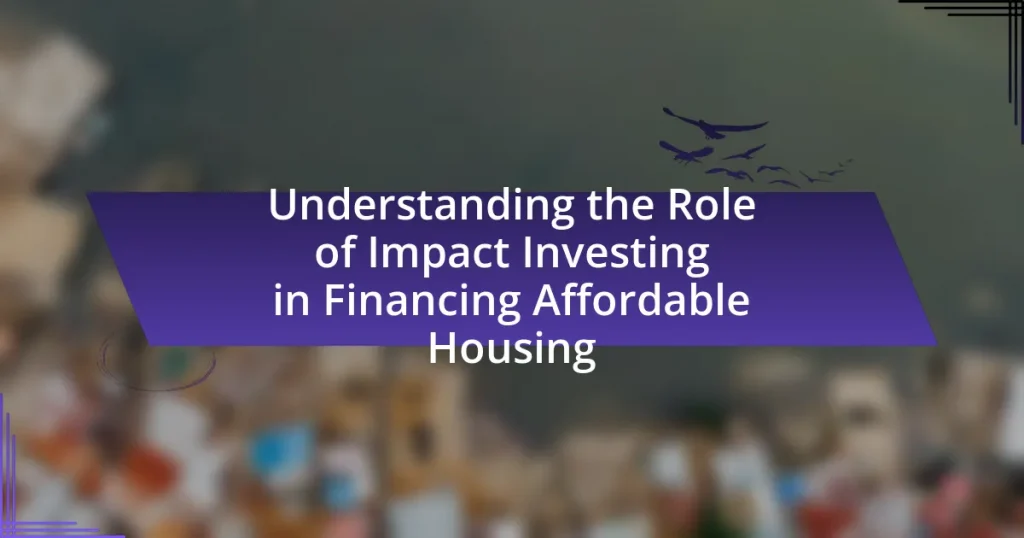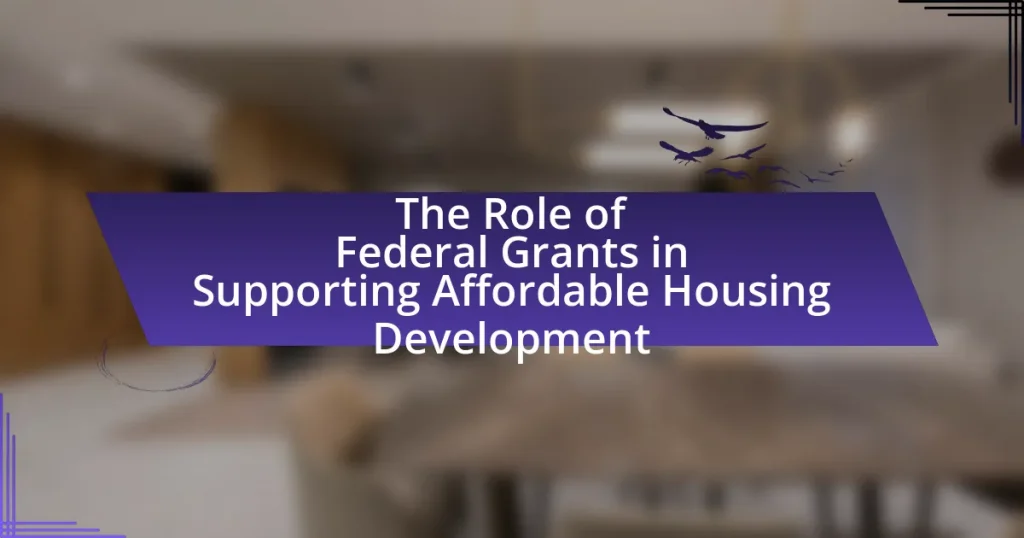Innovative financing models for affordable housing development encompass various mechanisms such as social impact bonds, community land trusts, and public-private partnerships. These models differ from traditional financing methods by offering flexible funding options and collaborative frameworks that address the unique challenges of affordable housing, including limited access to capital and high construction costs. The article explores the characteristics, benefits, and challenges of these innovative models, highlighting their effectiveness in increasing housing supply and accessibility. Additionally, it discusses the role of community needs, technology, and stakeholder collaboration in shaping successful financing strategies for affordable housing initiatives.

What are Innovative Financing Models for Affordable Housing Development?
Innovative financing models for affordable housing development include mechanisms such as social impact bonds, community land trusts, and public-private partnerships. Social impact bonds allow private investors to fund housing projects with the expectation of receiving returns based on the achievement of specific social outcomes, such as reduced homelessness. Community land trusts enable communities to acquire and manage land, ensuring long-term affordability by separating land ownership from housing ownership. Public-private partnerships leverage both public resources and private sector efficiency to develop affordable housing, often resulting in cost savings and increased project viability. These models have been shown to enhance funding availability and improve housing accessibility, as evidenced by successful implementations in various urban areas across the United States.
How do these financing models differ from traditional methods?
Innovative financing models differ from traditional methods primarily in their approach to funding and risk-sharing. Traditional financing typically relies on bank loans and government grants, which often impose strict eligibility criteria and lengthy approval processes. In contrast, innovative models, such as crowdfunding, social impact bonds, and public-private partnerships, leverage diverse funding sources and collaborative frameworks, allowing for more flexible and accessible financing options. For instance, crowdfunding platforms can mobilize small investments from a large number of individuals, bypassing conventional financial institutions. This shift not only democratizes access to capital but also encourages community involvement and investment in local housing projects.
What are the key characteristics of innovative financing models?
Innovative financing models are characterized by flexibility, collaboration, and risk-sharing mechanisms. These models adapt to the unique needs of affordable housing development by integrating diverse funding sources, such as public-private partnerships, social impact bonds, and community investment funds. For instance, the use of social impact bonds allows investors to fund projects that deliver measurable social outcomes, with returns linked to the success of those outcomes. Additionally, these models often leverage technology to streamline processes and enhance transparency, making it easier for stakeholders to engage and invest. The combination of these characteristics enables innovative financing models to effectively address funding gaps in affordable housing initiatives.
Why are innovative financing models necessary for affordable housing?
Innovative financing models are necessary for affordable housing because they address the funding gaps that traditional financing methods cannot fill. Conventional financing often falls short in meeting the diverse needs of low-income populations, leading to a significant shortfall in affordable housing units. For instance, the National Low Income Housing Coalition reported that there is a shortage of 7 million affordable rental homes for extremely low-income renters in the United States. Innovative models, such as social impact bonds and public-private partnerships, leverage multiple funding sources and create incentives for investment in affordable housing, thereby increasing the availability of housing options for those in need.
What challenges do these models address in affordable housing?
Innovative financing models for affordable housing address several key challenges, including limited access to capital, high construction costs, and insufficient government funding. These models, such as public-private partnerships and social impact bonds, enable diverse funding sources, reducing reliance on traditional financing methods. For instance, public-private partnerships leverage private investment to share risks and costs, making projects more feasible. Additionally, social impact bonds attract private investors by linking returns to measurable social outcomes, thus incentivizing investment in affordable housing. These approaches have been shown to increase the availability of affordable units and improve project sustainability, as evidenced by successful implementations in cities like New York and San Francisco, where innovative financing has led to the development of thousands of affordable housing units.
How do financing models impact housing supply and demand?
Financing models significantly impact housing supply and demand by influencing the availability of capital for development and the affordability of housing for consumers. For instance, traditional mortgage financing can limit access for low-income buyers, thereby reducing demand, while innovative financing models, such as community land trusts or social impact bonds, can increase supply by providing alternative funding sources and lowering costs. According to a study by the Urban Institute, areas utilizing innovative financing models saw a 20% increase in affordable housing units compared to those relying solely on conventional financing. This demonstrates that diverse financing options can enhance both the supply of housing and the ability of consumers to meet their housing needs.
What role do community needs play in shaping these models?
Community needs are fundamental in shaping innovative financing models for affordable housing development. These needs inform the design and implementation of financing strategies, ensuring they address specific local challenges such as housing affordability, accessibility, and sustainability. For instance, a study by the Urban Institute highlights that community engagement in the planning process leads to financing models that are more aligned with the actual needs of residents, resulting in higher occupancy rates and community satisfaction. By prioritizing community input, developers can create tailored solutions that effectively leverage public and private funding sources, ultimately enhancing the viability and impact of affordable housing projects.

What types of Innovative Financing Models exist for Affordable Housing Development?
Innovative financing models for affordable housing development include community land trusts, social impact bonds, and public-private partnerships. Community land trusts allow communities to acquire and manage land for affordable housing, ensuring long-term affordability. Social impact bonds involve private investors funding social programs with returns based on the achievement of specific outcomes, such as increased affordable housing units. Public-private partnerships leverage resources and expertise from both sectors to develop affordable housing projects, often resulting in shared risks and benefits. These models have been shown to effectively address funding gaps and enhance housing accessibility, as evidenced by successful implementations in various cities across the United States.
How do public-private partnerships function in this context?
Public-private partnerships (PPPs) function in the context of innovative financing models for affordable housing development by combining resources, expertise, and risk-sharing between government entities and private sector companies. These collaborations enable the efficient mobilization of capital and the implementation of housing projects that might be financially unfeasible for either party alone. For instance, a study by the Urban Institute highlights that PPPs can leverage private investment to enhance public housing initiatives, resulting in increased housing supply and improved living conditions. This model allows for the sharing of responsibilities, where the public sector provides regulatory support and land, while the private sector contributes funding and construction expertise, ultimately leading to more sustainable and affordable housing solutions.
What are the benefits of public-private partnerships for affordable housing?
Public-private partnerships (PPPs) for affordable housing provide several key benefits, including increased funding, risk sharing, and enhanced efficiency in project delivery. These partnerships leverage the financial resources and expertise of the private sector while utilizing the public sector’s regulatory framework and social objectives. For instance, a study by the Urban Institute highlights that PPPs can mobilize private investment, which is crucial given that public funding alone often falls short of meeting housing needs. Additionally, by sharing risks between public and private entities, projects can be more resilient to market fluctuations, leading to more sustainable housing solutions. Furthermore, the collaboration often results in streamlined processes and innovative approaches, reducing the time and costs associated with housing development.
What challenges do public-private partnerships face?
Public-private partnerships (PPPs) face several challenges, including misalignment of goals, funding issues, and regulatory hurdles. Misalignment occurs when the objectives of public entities differ from those of private partners, leading to conflicts in project execution. Funding issues arise from the difficulty in securing adequate financial resources, as private investors may be hesitant to commit without guaranteed returns. Regulatory hurdles can complicate the partnership process, as navigating complex legal frameworks often delays project timelines and increases costs. These challenges can hinder the effectiveness of PPPs in delivering affordable housing solutions.
What is the role of social impact investing in affordable housing?
Social impact investing plays a crucial role in affordable housing by directing capital towards projects that generate social benefits alongside financial returns. This investment approach enables developers to access necessary funding for constructing and maintaining affordable housing units, which are often underfunded through traditional financing methods. For instance, according to the Global Impact Investing Network, social impact investments in housing can help bridge the financing gap, as they often target underserved communities and prioritize social outcomes, such as improved living conditions and community stability. By aligning financial incentives with social goals, social impact investing fosters sustainable development in the affordable housing sector.
How does social impact investing differ from traditional investing?
Social impact investing differs from traditional investing primarily in its dual focus on financial returns and social or environmental impact. While traditional investing prioritizes maximizing financial profit, social impact investing seeks to generate measurable positive effects on society alongside financial gains. For instance, social impact investors often fund projects that address social issues, such as affordable housing, and evaluate success based on both financial performance and social outcomes, such as improved community well-being or reduced homelessness. This approach is supported by the growing trend of investors seeking to align their portfolios with their values, as evidenced by the rise of impact investment funds, which have seen significant growth, reaching over $715 billion in assets under management globally as of 2020.
What are the potential returns on social impact investments in housing?
Social impact investments in housing can yield both financial and social returns. Financially, these investments often provide competitive returns comparable to traditional real estate investments, with some studies indicating returns ranging from 5% to 10% annually. Socially, they contribute to community development, increased access to affordable housing, and improved living conditions, which can enhance property values and reduce social costs associated with homelessness and inadequate housing. For instance, a report by the Global Impact Investing Network highlights that investments in affordable housing not only generate financial returns but also lead to measurable improvements in community well-being and economic stability.

How can stakeholders effectively implement Innovative Financing Models?
Stakeholders can effectively implement Innovative Financing Models by fostering collaboration among public, private, and nonprofit sectors to pool resources and share risks. This collaborative approach enables the development of tailored financial solutions that address specific housing needs, such as social impact bonds or community investment funds. For instance, the use of social impact bonds has been shown to attract private investment for public projects, as evidenced by the success of the Peterborough Social Impact Bond in the UK, which reduced reoffending rates and generated savings for the government. By leveraging diverse funding sources and aligning incentives, stakeholders can create sustainable financing mechanisms that enhance affordable housing development.
What strategies can developers use to attract investors?
Developers can attract investors by presenting a clear value proposition that highlights the potential return on investment and social impact of affordable housing projects. This involves conducting thorough market research to demonstrate demand, showcasing successful case studies, and outlining a solid business plan that includes financial projections and risk assessments. For instance, a report by the Urban Land Institute indicates that affordable housing investments can yield stable returns due to consistent demand, making them appealing to socially conscious investors. Additionally, leveraging partnerships with local governments and non-profits can enhance credibility and provide access to funding sources, further attracting investor interest.
How can developers demonstrate the viability of their projects?
Developers can demonstrate the viability of their projects by conducting thorough market research and presenting detailed financial projections. Market research provides insights into demand, competition, and target demographics, which are essential for validating the project’s potential success. Financial projections, including cash flow analysis, return on investment, and break-even analysis, offer quantitative evidence of the project’s profitability. For instance, a study by the Urban Institute found that projects with comprehensive financial modeling are 30% more likely to secure funding, underscoring the importance of these elements in demonstrating viability.
What metrics are important for investors in affordable housing?
Key metrics important for investors in affordable housing include return on investment (ROI), occupancy rates, operating expenses, and cash flow. ROI measures the profitability of the investment, while occupancy rates indicate the demand and stability of rental income. Operating expenses provide insight into the cost efficiency of the property, and cash flow assesses the liquidity and financial health of the investment. According to the National Low Income Housing Coalition, properties with higher occupancy rates and lower operating expenses tend to yield better financial performance, making these metrics crucial for informed investment decisions.
What best practices should be followed in financing affordable housing?
Best practices in financing affordable housing include leveraging public-private partnerships, utilizing low-income housing tax credits, and implementing community land trusts. Public-private partnerships enable shared risk and resources, enhancing project viability. Low-income housing tax credits provide financial incentives that attract private investment, evidenced by the creation of over 3 million affordable housing units since their inception in 1986. Community land trusts ensure long-term affordability by separating land ownership from housing, which has proven effective in stabilizing neighborhoods and preventing displacement. These strategies collectively enhance the sustainability and accessibility of affordable housing projects.
How can collaboration among stakeholders enhance financing efforts?
Collaboration among stakeholders enhances financing efforts by pooling resources, expertise, and networks, which leads to more effective funding strategies. When various stakeholders, such as government agencies, non-profits, and private investors, work together, they can leverage each other’s strengths to create comprehensive financing solutions. For instance, a study by the Urban Institute found that collaborative approaches in affordable housing projects can increase funding availability by up to 30%, as stakeholders share risks and align their goals. This synergy not only attracts more investment but also fosters innovative financing models that address specific community needs, ultimately improving the viability and sustainability of affordable housing developments.
What common pitfalls should be avoided in financing models?
Common pitfalls to avoid in financing models for affordable housing development include inadequate risk assessment, lack of stakeholder engagement, and insufficient financial forecasting. Inadequate risk assessment can lead to unforeseen financial challenges, as evidenced by projects that failed due to unanticipated costs or market fluctuations. Lack of stakeholder engagement often results in misalignment of goals, which can derail projects; for instance, community opposition can arise when local needs are not considered. Insufficient financial forecasting can lead to budget shortfalls, as seen in various housing initiatives that underestimated operational costs. Addressing these pitfalls is crucial for the success of financing models in affordable housing development.
What are the future trends in Innovative Financing Models for Affordable Housing Development?
Future trends in innovative financing models for affordable housing development include increased use of public-private partnerships, impact investing, and technology-driven solutions such as blockchain for transparency and efficiency. Public-private partnerships are gaining traction as they leverage both government resources and private sector expertise to create sustainable housing solutions. Impact investing is on the rise, with investors seeking social returns alongside financial gains, thus directing capital towards affordable housing projects. Additionally, technology is transforming financing through platforms that facilitate crowdfunding and streamline transactions, making it easier for developers to access funds. These trends are supported by the growing recognition of the housing crisis and the need for scalable, effective solutions to meet demand.
How might technology influence financing models in the future?
Technology will significantly influence financing models in the future by enabling more efficient, transparent, and accessible funding mechanisms. Innovations such as blockchain can streamline transactions, reduce fraud, and enhance trust among stakeholders, while artificial intelligence can analyze data to optimize investment decisions and risk assessments. For instance, a report by the World Economic Forum highlights that blockchain technology can facilitate smart contracts, which automate and enforce agreements, thereby reducing costs and time associated with traditional financing methods. Additionally, crowdfunding platforms have emerged as viable alternatives, allowing individuals to invest in affordable housing projects directly, democratizing access to capital. These advancements indicate a shift towards more inclusive and flexible financing models in the housing sector.
What emerging trends should stakeholders be aware of?
Stakeholders should be aware of the trend towards impact investing in affordable housing, which prioritizes social and environmental outcomes alongside financial returns. This trend is driven by a growing recognition of the need for sustainable housing solutions, as evidenced by the Global Impact Investing Network reporting that impact investing assets reached $715 billion in 2020, indicating a significant shift in capital allocation towards socially responsible projects. Additionally, the rise of public-private partnerships is facilitating innovative financing models, allowing for shared risk and increased investment in affordable housing initiatives.
What practical tips can stakeholders apply to enhance financing success?
Stakeholders can enhance financing success by diversifying funding sources, which mitigates risk and increases financial stability. Engaging with public-private partnerships can leverage additional resources and expertise, as evidenced by successful models in cities like San Francisco, where collaboration has led to increased affordable housing units. Additionally, stakeholders should prioritize transparent communication with investors, as clear reporting on project progress and financial health fosters trust and encourages further investment. Implementing data-driven decision-making can also optimize resource allocation, demonstrated by studies showing that data analytics in housing projects can improve funding outcomes by up to 30%.



